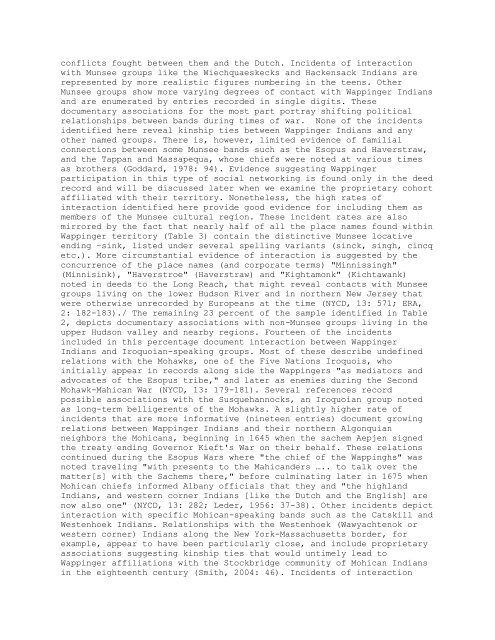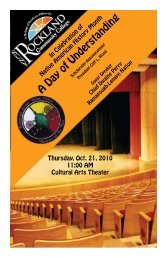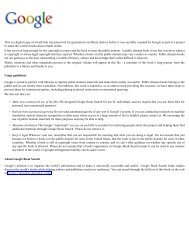Native American 1696 Land Deed for Most of Hyde Park, New York
Native American 1696 Land Deed for Most of Hyde Park, New York
Native American 1696 Land Deed for Most of Hyde Park, New York
Create successful ePaper yourself
Turn your PDF publications into a flip-book with our unique Google optimized e-Paper software.
conflicts fought between them and the Dutch. Incidents <strong>of</strong> interaction<br />
with Munsee groups like the Wiechquaeskecks and Hackensack Indians are<br />
represented by more realistic figures numbering in the teens. Other<br />
Munsee groups show more varying degrees <strong>of</strong> contact with Wappinger Indians<br />
and are enumerated by entries recorded in single digits. These<br />
documentary associations <strong>for</strong> the most part portray shifting political<br />
relationships between bands during times <strong>of</strong> war. None <strong>of</strong> the incidents<br />
identified here reveal kinship ties between Wappinger Indians and any<br />
other named groups. There is, however, limited evidence <strong>of</strong> familial<br />
connections between some Munsee bands such as the Esopus and Haverstraw,<br />
and the Tappan and Massapequa, whose chiefs were noted at various times<br />
as brothers (Goddard, 1978: 94). Evidence suggesting Wappinger<br />
participation in this type <strong>of</strong> social networking is found only in the deed<br />
record and will be discussed later when we examine the proprietary cohort<br />
affiliated with their territory. Nonetheless, the high rates <strong>of</strong><br />
interaction identified here provide good evidence <strong>for</strong> including them as<br />
members <strong>of</strong> the Munsee cultural region. These incident rates are also<br />
mirrored by the fact that nearly half <strong>of</strong> all the place names found within<br />
Wappinger territory (Table 3) contain the distinctive Munsee locative<br />
ending –sink, listed under several spelling variants (sinck, singh, cincq<br />
etc.). More circumstantial evidence <strong>of</strong> interaction is suggested by the<br />
concurrence <strong>of</strong> the place names (and corporate terms) "Minnissingh"<br />
(Minnisink), "Haverstroe" (Haverstraw) and "Kightamonk" (Kichtawank)<br />
noted in deeds to the Long Reach, that might reveal contacts with Munsee<br />
groups living on the lower Hudson River and in northern <strong>New</strong> Jersey that<br />
were otherwise unrecorded by Europeans at the time (NYCD, 13: 571; ERA,<br />
2: 182-183)./ The remaining 23 percent <strong>of</strong> the sample identified in Table<br />
2, depicts documentary associations with non-Munsee groups living in the<br />
upper Hudson valley and nearby regions. Fourteen <strong>of</strong> the incidents<br />
included in this percentage document interaction between Wappinger<br />
Indians and Iroquoian-speaking groups. <strong>Most</strong> <strong>of</strong> these describe undefined<br />
relations with the Mohawks, one <strong>of</strong> the Five Nations Iroquois, who<br />
initially appear in records along side the Wappingers "as mediators and<br />
advocates <strong>of</strong> the Esopus tribe," and later as enemies during the Second<br />
Mohawk-Mahican War (NYCD, 13: 179-181). Several references record<br />
possible associations with the Susquehannocks, an Iroquoian group noted<br />
as long-term belligerents <strong>of</strong> the Mohawks. A slightly higher rate <strong>of</strong><br />
incidents that are more in<strong>for</strong>mative (nineteen entries) document growing<br />
relations between Wappinger Indians and their northern Algonquian<br />
neighbors the Mohicans, beginning in 1645 when the sachem Aepjen signed<br />
the treaty ending Governor Kieft's War on their behalf. These relations<br />
continued during the Esopus Wars where "the chief <strong>of</strong> the Wappinghs" was<br />
noted traveling "with presents to the Mahicanders ….. to talk over the<br />
matter[s] with the Sachems there," be<strong>for</strong>e culminating later in 1675 when<br />
Mohican chiefs in<strong>for</strong>med Albany <strong>of</strong>ficials that they and "the highland<br />
Indians, and western corner Indians [like the Dutch and the English] are<br />
now also one" (NYCD, 13: 282; Leder, 1956: 37-38). Other incidents depict<br />
interaction with specific Mohican-speaking bands such as the Catskill and<br />
Westenhoek Indians. Relationships with the Westenhoek (Wawyachtenok or<br />
western corner) Indians along the <strong>New</strong> <strong>York</strong>-Massachusetts border, <strong>for</strong><br />
example, appear to have been particularly close, and include proprietary<br />
associations suggesting kinship ties that would untimely lead to<br />
Wappinger affiliations with the Stockbridge community <strong>of</strong> Mohican Indians<br />
in the eighteenth century (Smith, 2004: 46). Incidents <strong>of</strong> interaction





